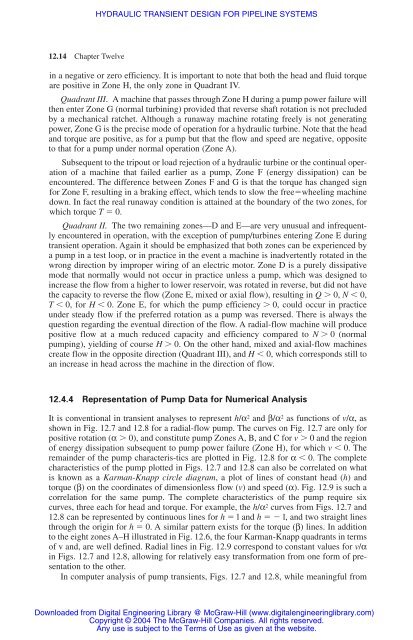chapter 12 hydraulic transient design for pipeline systems
chapter 12 hydraulic transient design for pipeline systems
chapter 12 hydraulic transient design for pipeline systems
Create successful ePaper yourself
Turn your PDF publications into a flip-book with our unique Google optimized e-Paper software.
<strong>12</strong>.14 Chapter Twelve<br />
HYDRAULIC TRANSIENT DESIGN FOR PIPELINE SYSTEMS<br />
in a negative or zero efficiency. It is important to note that both the head and fluid torque<br />
are positive in Zone H, the only zone in Quadrant IV.<br />
Quadrant III. A machine that passes through Zone H during a pump power failure will<br />
then enter Zone G (normal turbining) provided that reverse shaft rotation is not precluded<br />
by a mechanical ratchet. Although a runaway machine rotating freely is not generating<br />
power, Zone G is the precise mode of operation <strong>for</strong> a <strong>hydraulic</strong> turbine. Note that the head<br />
and torque are positive, as <strong>for</strong> a pump but that the flow and speed are negative, opposite<br />
to that <strong>for</strong> a pump under normal operation (Zone A).<br />
Subsequent to the tripout or load rejection of a <strong>hydraulic</strong> turbine or the continual operation<br />
of a machine that failed earlier as a pump, Zone F (energy dissipation) can be<br />
encountered. The difference between Zones F and G is that the torque has changed sign<br />
<strong>for</strong> Zone F, resulting in a braking effect, which tends to slow the free�wheeling machine<br />
down. In fact the real runaway condition is attained at the boundary of the two zones, <strong>for</strong><br />
which torque T � 0.<br />
Quadrant II. The two remaining zones—D and E—are very unusual and infrequently<br />
encountered in operation, with the exception of pump/turbines entering Zone E during<br />
<strong>transient</strong> operation. Again it should be emphasized that both zones can be experienced by<br />
a pump in a test loop, or in practice in the event a machine is inadvertently rotated in the<br />
wrong direction by improper wiring of an electric motor. Zone D is a purely dissipative<br />
mode that normally would not occur in practice unless a pump, which was <strong>design</strong>ed to<br />
increase the flow from a higher to lower reservoir, was rotated in reverse, but did not have<br />
the capacity to reverse the flow (Zone E, mixed or axial flow), resulting in Q � 0, N � 0,<br />
T � 0, <strong>for</strong> H � 0. Zone E, <strong>for</strong> which the pump efficiency � 0, could occur in practice<br />
under steady flow if the preferred rotation as a pump was reversed. There is always the<br />
question regarding the eventual direction of the flow. A radial-flow machine will produce<br />
positive flow at a much reduced capacity and efficiency compared to N � 0 (normal<br />
pumping), yielding of course H � 0. On the other hand, mixed and axial-flow machines<br />
create flow in the opposite direction (Quadrant III), and H � 0, which corresponds still to<br />
an increase in head across the machine in the direction of flow.<br />
<strong>12</strong>.4.4 Representation of Pump Data <strong>for</strong> Numerical Analysis<br />
It is conventional in <strong>transient</strong> analyses to represent h/α 2 and β/α 2 as functions of v/α, as<br />
shown in Fig. <strong>12</strong>.7 and <strong>12</strong>.8 <strong>for</strong> a radial-flow pump. The curves on Fig. <strong>12</strong>.7 are only <strong>for</strong><br />
positive rotation (α � 0), and constitute pump Zones A, B, and C <strong>for</strong> v � 0 and the region<br />
of energy dissipation subsequent to pump power failure (Zone H), <strong>for</strong> which v � 0. The<br />
remainder of the pump characteris-tics are plotted in Fig. <strong>12</strong>.8 <strong>for</strong> α � 0. The complete<br />
characteristics of the pump plotted in Figs. <strong>12</strong>.7 and <strong>12</strong>.8 can also be correlated on what<br />
is known as a Karman-Knapp circle diagram, a plot of lines of constant head (h) and<br />
torque (β) on the coordinates of dimensionless flow (v) and speed (α). Fig. <strong>12</strong>.9 is such a<br />
correlation <strong>for</strong> the same pump. The complete characteristics of the pump require six<br />
curves, three each <strong>for</strong> head and torque. For example, the h/α 2 curves from Figs. <strong>12</strong>.7 and<br />
<strong>12</strong>.8 can be represented by continuous lines <strong>for</strong> h � l and h ��l, and two straight lines<br />
through the origin <strong>for</strong> h � 0. A similar pattern exists <strong>for</strong> the torque (β) lines. In addition<br />
to the eight zones A–H illustrated in Fig. <strong>12</strong>.6, the four Karman-Knapp quadrants in terms<br />
of v and, are well defined. Radial lines in Fig. <strong>12</strong>.9 correspond to constant values <strong>for</strong> v/α<br />
in Figs. <strong>12</strong>.7 and <strong>12</strong>.8, allowing <strong>for</strong> relatively easy trans<strong>for</strong>mation from one <strong>for</strong>m of presentation<br />
to the other.<br />
In computer analysis of pump <strong>transient</strong>s, Figs. <strong>12</strong>.7 and <strong>12</strong>.8, while meaningful from<br />
Downloaded from Digital Engineering Library @ McGraw-Hill (www.digitalengineeringlibrary.com)<br />
Copyright © 2004 The McGraw-Hill Companies. All rights reserved.<br />
Any use is subject to the Terms of Use as given at the website.
















